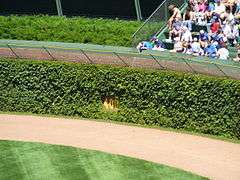Parthenocissus tricuspidata
| Parthenocissus tricuspidata | |
|---|---|
.jpg) | |
| Foliage on a cultivated plant | |
| Scientific classification | |
| Kingdom: | Plantae |
| Clade: | Angiosperms |
| Clade: | Eudicots |
| Clade: | Rosids |
| Order: | Vitales |
| Family: | Vitaceae |
| Genus: | Parthenocissus |
| Species: | P. tricuspidata |
| Binomial name | |
| Parthenocissus tricuspidata (Siebold & Zucc.) Planch. | |
| Parthenocissus tricuspidata | |||||||
| Chinese name | |||||||
|---|---|---|---|---|---|---|---|
| Traditional Chinese | 爬牆虎 | ||||||
| Simplified Chinese | 爬墙虎 | ||||||
| Literal meaning | "wall-climbing tiger" | ||||||
| |||||||
| Japanese name | |||||||
| Kana | ツタ | ||||||
| |||||||
Parthenocissus tricuspidata is a flowering plant in the grape family (Vitaceae) native to eastern Asia in Japan, Korea, and northern and eastern China. Although unrelated to true ivy, it is commonly known as Boston Ivy, grape ivy, and Japanese ivy, and also as Japanese creeper, and by the name woodbine (though the latter may refer to a number of different vine species).
It is a deciduous woody vine growing to 30 m tall or more given suitable support, attaching itself by means of numerous small branched tendrils tipped with sticky disks. The leaves are simple, palmately lobed with three lobes, occasionally unlobed or with five lobes, or sufficiently deeply lobed to be palmately compound with (usually) three leaflets; the leaves range from 5 to 22 cm across. The flowers are inconspicuous, greenish, in clusters; the fruit is a small dark blue grape 5–10 mm diameter.
The specific epithet tricuspidata means three-pointed, referring to the leaf shape.[1]
Cultivation and uses
Like the related Virginia creeper, this plant is widely grown as a climbing ornamental plant to cover the façades of masonry buildings. This usage is actually economically important because, by shading walls during the summer, it can significantly reduce cooling costs.
Boston Ivy is readily distinguished from the Virginia creeper by the simple leaves (always palmately compound with 5 leaflets in Virginia creeper).
The plant secretes calcium carbonate,[2] which serves as an adhesive pad and gives it the ability to attach itself to a wall without requiring any additional support. While it does not penetrate the building surface but merely attaches to it, nevertheless damage can occur from attempting to rip the plant from the wall. However, if the plant is killed first, such as by severing the vine from the root, the adhesive pads will eventually deteriorate to the point where the plant can be easily removed without causing any damage to the wall.
It is used on the brick outfield walls at Wrigley Field of the Chicago Cubs.
Cultivars include 'Veitchii'.[3]
Etymology
‘Parthenocissus’ is derived from Greek and means ‘virgin ivy’ (hence the common name ‘Virginia creeper’).[4]
‘Tricuspidata’ ‘with three cuspids’ ‘tri’ – ‘three’, ‘cuspidata’ – ‘cuspid’, ‘tooth’.[4]
References
- ↑ Harrison, Lorraine (2012). RHS Latin for gardeners. United Kingdom: Mitchell Beazley. p. 224. ISBN 9781845337315.
- ↑ Jason Canon. "'The Ivy League'".
- ↑ BBC Plant finder: Boston Ivy
- 1 2 Gledhill, David (2008). "The Names of Plants". Cambridge University Press. ISBN 9780521866453 (hardback), ISBN 9780521685535 (paperback). pp 292, 386
- Boston ivy covering the exterior of an apartment building near Kips Bay, Manhattan
 Boston ivy covering a building on the University of Chicago campus
Boston ivy covering a building on the University of Chicago campus Japanese creeper growing over a brick wall at the University of Cambridge.
Japanese creeper growing over a brick wall at the University of Cambridge. Sticky disks of Parthenocissus tricuspidata
Sticky disks of Parthenocissus tricuspidata Wrigley Field's famous ivy covered outfield walls.
Wrigley Field's famous ivy covered outfield walls..jpg) Stone house covered with Boston ivy in Kalamata
Stone house covered with Boston ivy in Kalamata
See also
| Wikimedia Commons has media related to Parthenocissus tricuspidata. |